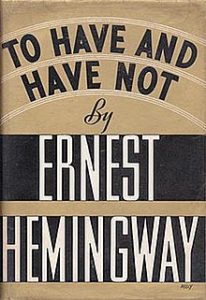
To Have and Have Not
By Ernest Hemingway
176 pages
First published Jan. 1, 1937 by Charles Scribner’s Sons
To Have and Have Not follows Harry Morgan, a fishing boat captain during the Great Depression who is forced by economic circumstances into running contraband between Cuba and Key West. Written sporadically between 1935 and 1937 as Hemingway traveled back and forth from Spain during the Spanish Civil War, the book was clearly influenced by the Marxist ideology he was exposed to at the time.
I read it as an antidote to Vauhini Vara’s The Immortal King Rao, the almost unbearable novel I reviewed on June 21. After suffering through her improbable plot, unbelievable characters, and purple prose, I needed something clean and straight. Like three fingers of Jose Cuervo Familia Reserva after a strawberry daiquiri.
To Have and Have Not is not one of Hemingway’s most appreciated novels. In fact, it was severely panned by J. Donald Adams in The New York Times:
“In spite of its frequent strength as narrative writing, To Have and Have Not is a novel distinctly inferior to A Farewell to Arms…. Mr. Hemingway’s record as a creative writer would be stronger if it had never been published.”
I wouldn’t argue that it was as good as A Farewell to Arms. But that’s not a fair comparison. To Have and Have Not is genre fiction. And as genre fiction, it is very good. For me, the plot is strong, as strong as Dashiell Hammett’s The Maltese Falcon. And the dialog is rich, like the dialog of Raymond Chandler’s The Big Sleep. And the characters are wonderfully bad, like those in Jim Thompson’s The Killer Inside Me.
Interesting
The 1944 film starring Humphrey Bogart and Lauren Bacall is only loosely based on the book. The story was switched to the underground French resistance during WWII because it was believed that Hemingway’s portrayal of Cuba’s government was in violation of President Roosevelt’s “Good Neighbor” policy toward Latin American countries.
